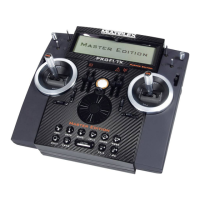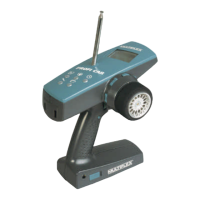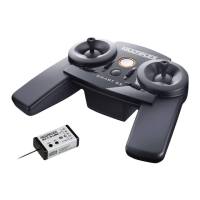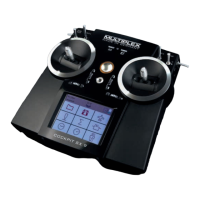The Concept
- 2 -
The
MULTIPLEX
Concept
The individual steps in programming and adjusting a
helicopter are easier to understand if you are already
clear in your mind about the basic philosophy behind
the PROFI mc 4000 system, i.e. the „HOW’S“ and
„WHY’S“. That is the purpose of this first section.
How is model data stored in the
transmitter?
Every model memory contains the following:
1. The transmitter control assignment
Which control on the transmitter
controls which function.
2. The servo assignments
Which servo operates which function in the model.
3. The switch assignments
Which switch implements which change
4. The transmitter control settings which are the
same for all flight modes
e.g. trim travel, slow, ...
5. The transmitter control adjustments which may
vary from one flight mode to the other,
e.g. **
6. Servo settings
e.g. centre, direction, travel, limit, ...
7. Mixer settings
The settings for switches, timers and other auxil-
iary functions.
When you are just starting to program a model we
recommend that you start by assigning a name to the
model memory. This helps to keep the whole system
comprehensible, and makes it much easier for you to
re-locate particular models in the transmitter’s mem-
ory. Just a quick reminder: when you switch memories
you will find the model names in alphabetical order
when you „leaf through“ them on screen.
A few words about ...
FLIGHT MODES
What actually is a flight mode?
We use the term „flight mode“ for the
transmitter
control
settings which are associated with a particular
flight situation. For any model you can store five dif-
ferent sets of adjustments to cope with different situa-
tions.
Examples:
The throttle curve is the usual helicopter term for a
collective pitch - throttle mixer. When you are
HOVERING you need a particular throttle curve, but
for aerobatic flying you need a different curve. No
problem: for each flight mode the throttle curve can
have many points and as many different values.
For AUTO-ROTATION - or if you are using a gyro -
COLLECTIVE PITCH must not be mixed in with the
tail rotor. The COLLECTIVE PITCH input to control
the tail rotor is replaced by a fixed value (FIXED
VALUE) when you select the auto-rotation mode.
Which transmitter control settings can be
altered for different flight modes?
You may have noticed already that we did not even
mention servos or mixers when explaining the concept
of flight modes. There is a good reason for this:
TIP:
Different flight modes may have different
transmitter control settings, but that is all.
Servo settings always apply unchanged
to all flight modes.
It could be difficult to remember which transmitter
control settings can be changed, so we have built in a
simple aid to memory:
Whenever you change settings which are flight mode
dependent, i.e. can vary from flight mode to flight
mode, the top line of the screen shows the number
and name of the currently active flight mode.
Example: throttle curve for hovering at 1350 rpm
\iN)i
[DNE@DDQFiVBEWF
2iiiiiiiiiii2ii5
2iiiiiiiiii2?\i
In our example flight mode 4 is active, and its name is
„Hover1300“. That is what the first line tells us.
In the second line the screen states which curve is
shown in the bottom part of the display.
In the right-hand bottom corner
?\i
indicates that
you are currently adjusting the third point on the
curve. Directly above this you see the current value
for this point (
5
).
Example: trim travel and trim method
V@YDEiiKi\V@Q.?ADVNS
[DEAZiDEIW
-VFYDEFiiiiiiii5]
In this example the top line is empty, and this tells you
that the transmitter control setting you are adjusting
(trim travel and trim method) applies to all flight
modes.
